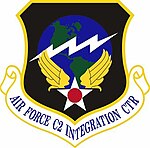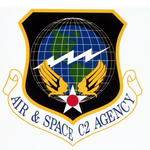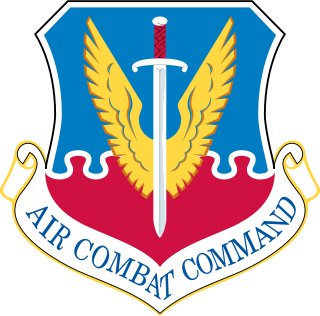
Air Combat Command (ACC) is one of nine Major Commands (MAJCOMs) in the United States Air Force, reporting to Headquarters, United States Air Force (HAF) at the Pentagon. It is the primary provider of air combat forces for the Air Force, and it is the direct successor to Tactical Air Command. Air Combat Command is headquartered at Langley Air Force Base, Joint Base Langley–Eustis, Virginia, United States.

The Sixteenth Air Force is a United States Air Force (USAF) organization responsible for information warfare, which encompasses intelligence gathering and analysis, surveillance, reconnaissance, cyber warfare and electronic warfare operations. Its headquarters is at Joint Base San Antonio-Lackland in Texas.

The 2nd Space Operations Squadron is a United States Space Force unit responsible for operating the Global Positioning System (GPS) satellite constellation, which provides global navigation, time transfer, and nuclear detonation detection. It is a component of Space Operations Command's Space Delta 8 and headquartered at Schriever Space Force Base, Colorado.

The 480th Intelligence, Surveillance, and Reconnaissance Wing is headquartered at Langley Air Force Base, Virginia.

The 67th Cyberspace Operations Group is a unit of the 67th Cyberspace Wing. Headquartered on Kelly Field Annex's Security Hill, the group is an Air Force information operations unit.
The UAV Battlelab is a U.S. Air Force flight test and development facility specifically dedicated to developing unmanned aerial vehicles. One of six original Air Force battlelabs established in 1997, this battlelab falls directly under the Air Warfare Center and recently moved to Creech Air Force Base, located near Indian Springs, Nevada from Eglin Air Force Base, Florida.

The 544th Intelligence, Surveillance and Reconnaissance Group was a United States Air Force unit assigned to the Air Force Space Command Fourteenth Air Force. It was last stationed at Peterson Air Force Base, Colorado. It was inactivated in the summer of 2020 as part of the establishment of an independent US Space Force.

The 18th Intelligence Squadron was a space intelligence organization of the United States Air Force, located at Wright-Patterson Air Force Base, Ohio.

The 940th Air Refueling Wing is part of the Air Reserve Component of the United States Air Force. It is assigned to the Fourth Air Force of the Air Force Reserve Command, is operationally-gained by the Air Mobility Command, and is home stationed at Beale Air Force Base, California.
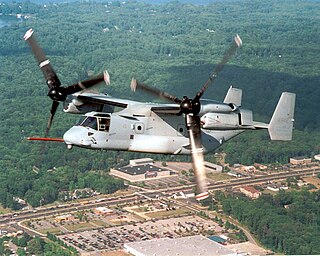
Twenty-Third Air Force was a Numbered Air Force that was assigned to Air Force Special Operations Command. It was stationed at Hurlburt Field, Florida and was active from 1 January 2008 until 4 April 2013. It served as the operational headquarters for Air Force special operations forces assigned to joint and combined commands. Starting in 2012, it transferred operational control of some of its units to other headquarters; its remaining functions were assumed by the Air Force Special Operations Command Air Operations Center when it was inactivated the following year.

The 16th Airborne Command and Control Squadron is a United States Air Force flying unit assigned to Air Combat Command's 461st Air Control Wing, 461st Operations Group, stationed at Robins Air Force Base, Georgia. The squadron flies the Northrop Grumman E-8C JSTARS, providing airborne battle management, command and control, surveillance, and target acquisition.

The 363rd Intelligence, Surveillance and Reconnaissance Wing is a United States Air Force unit. The group is assigned to the United States Air Force Sixteenth Air Force, stationed at Joint Base Langley-Eustis, Virginia.

Richard E. Webber is a retired United States Air Force major general. He was the first commander of the Twenty-Fourth Air Force, which is focused on cyberspace operations. The Twenty-Fourth Air Force is located in San Antonio, Texas, and stood up in place of the originally proposed larger Major Command organization, Air Force Cyber Command. Webber graduated from the United States Air Force Academy in 1975 and has worked in the space and missile career field.

The United States Air Force's 543d Intelligence, Surveillance and Reconnaissance Group is an intelligence unit located at Joint Base San Antonio, Texas. It has been located there since 1997, when it was activated as the 543d Intelligence Group. It focuses on cryptologic operations and signals intelligence.
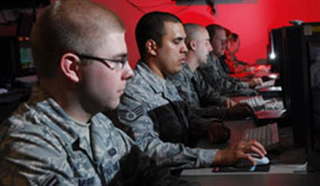
The United States Air Force's 497th Intelligence, Surveillance and Reconnaissance Group is an intelligence unit located at Joint Base Langley–Eustis, Virginia.

The Curtis E. LeMay Center for Doctrine Development and Education

The 27th Intelligence Squadron is an active squadron of the United States Air Force, stationed at Langley Air Force Base, part of Joint Base Langley-Eustis, near Hampton, Virginia. It is assigned to the 480th Intelligence, Surveillance and Reconnaissance Wing.

The 30th Intelligence Squadron is an active United States Air Force unit, stationed at Langley Air Force Base, Virginia and operating Distributed Ground Station-1 in association with reserve and Virginia Air National Guard squadrons.

Space Operations Command (SpOC) is the United States Space Force's space operations, cyber operations, and intelligence field command. It is headquartered at Peterson Space Force Base, Colorado and serves as the U.S. Space Force's service component to United States Space Command. Space Operations Command consists of Space Operations Command West, its mission deltas, and garrison commands.
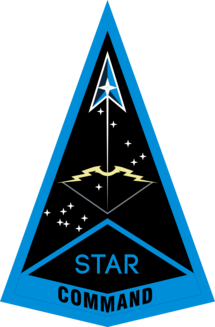
Space Training and Readiness Command is the United States Space Force's education, training, doctrine, and test field command. It is headquartered at Peterson Space Force Base, Colorado.
